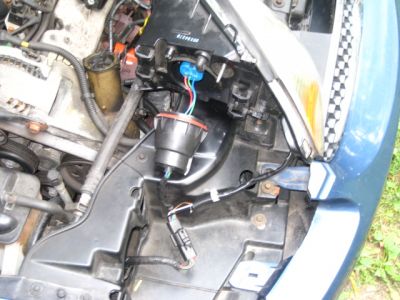Brilliant! Instead of repairing the broken ground wire on one side, which would take the better part of ten minutes, you opted for the unacceptable solution of running a wire the engineers at Ford were too stupid to install at the factory.
I taught my students that running a new wire is rarely acceptable. As a supervisor in a shop, I would never allow my customers' cars to be repaired with a cobble-job like that, and you will never get your car back with that type of repair. The original wire became cut on the sharp edge of a metal bracket, or it rubbed back and forth until it grounded out on the body sheet metal, and grounded out, both of which are much more common than you'd expect. We need to identify exactly where that occurred because how long will it be before the next wire in that harness will do the same thing? Every professional who has their customers' best interest at heart would never let a car go knowing a new problem was potentially going to occur in the near future. What part of the country, late at night, will you be sitting on the side of the road?
Cutting the ground wire on the dim head light is not necessary. You're installing a break in a wire that is already malfunctioning because it has a break in it. Also, why would you run to the ground wire way over on the other side of the car? You could have just tapped into the ground wire, ran the new wire less than 12", and bolted it to the body.
There's two other potential problems. The first is Ford is very famous for running the ground wires for multiple, unrelated circuits to a single terminal, then bolting that to the body sheet metal. If that terminal is corroded or loose, the head light current is going to look for an alternate path to ground, and it may find that by back-feeding through the running lights, the washer pump motor, or the horn. That can cause all kinds of conflicting symptoms with elusive solutions. Running a new wire the way you did could make the head light work properly, but it wouldn't address all the other problems. You could end up repairing a half dozen problems, each taking over an hour to diagnose and solve. That is hardly the responsible way to take care of our customer. In my city with over a dozen new-car dealers and about 50 independent repair shops, we are lucky to have only the Chevy dealer still in business who is a widely-well-known crook. We did have one independent shop rip-off artist, but the community put him out of business. Anyone finding this type of "repair" would want to find out where it was done so we could stop recommending them as a reputable shop.
Speaking of back-feeding, the first clue the ground wire was broken was the head light was dim, not out completely. To be dim, some current had to be going through it, but how could it do that with the broken ground wire? The second clue would have been to disconnect the left head lamp. You would have seen the dim right bulb would have gone out. Current goes through the right low beam filament, can't get to ground by normal means, but back-tracks through the high-beam filament, then over to the high-beam on the left side since they're tied together. It goes through that filament, then to ground on the left side. The 12 volts was divided up between three filaments instead of one. That's why the right side is on but less than full brightness. The additional clue is the high-beam indicator on the dash is tied in with that circuit, so it will be on dim all the time.
The second problem is 2003 was just about when the use of unnecessary, complicated, and unreliable computers made their way to lighting systems. On many cars, the ground circuit doesn't go the body any more. The two individual grounds run through the Body Computer first, then to ground, so those circuits can be monitored. In this situation, you'd have twice the ground current as expected on the left ground and 0 amps on the right ground, both of which would set diagnostic fault codes. Legitimate problems would not be able to be detected by that computer. Also, starting around 2000 to 2002, the instrument cluster became the most "intelligent", (complicated), computer on Ford products. My description of the high-beam indicator being on dim won't apply, so that potential clue isn't available.
The bottom line is there is no arguing you may have two properly-working head lights, but the way you accomplished it is not what we want other do-it-yourselfers to think is an acceptable repair. The correct repair is much easier and when we have to bill our time by the hour, is the only way a conscientious mechanic would approach this. We have enough trouble already with a bad reputation for the entire industry. Most of it is undeserved, and we would never back a shop that produced this kind of work for paying customers. To leave your solution unanswered would leave our visitors with the false impression we approve of it. That would do them a huge disservice and destroy our credibility.
Friday, June 26th, 2020 AT 12:16 PM
(Merged)

